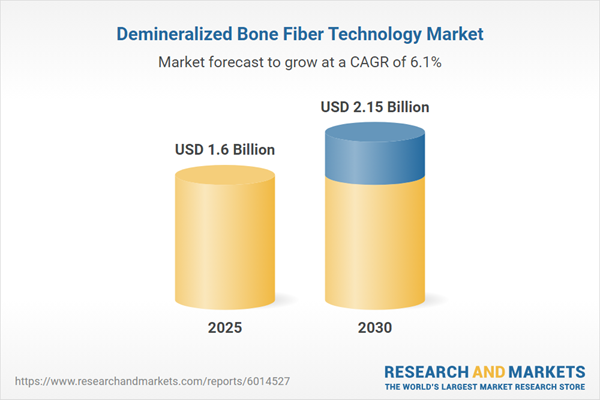Speak directly to the analyst to clarify any post sales queries you may have.
The demineralized bone fiber technology market is transforming procurement strategies and surgical planning for healthcare organizations by delivering clinically adaptive, next-generation biomaterial solutions. For senior decision-makers, this market offers new pathways to streamline operations, ensure compliance, and elevate patient care through advanced graft innovation.
Market Snapshot: Demineralized Bone Fiber Technology Market
The global demineralized bone fiber technology market grew from USD 1.51 billion in 2024 to USD 1.60 billion by 2025, reflecting a compound annual growth rate (CAGR) of 6.23%. Projections suggest further momentum, with the market expected to reach USD 2.45 billion by 2032. This sustained trajectory results from robust investment in healthcare infrastructure and ongoing innovation in biomaterial science. As hospital systems adjust to new clinical regulations and technologies, procurement leaders are recalibrating their frameworks to support streamlined operations and improved clinical outcomes.
Scope & Segmentation
- Product Types: Bone fiber, granule, and powder formats serve diverse clinical demands, enabling hospitals and clinics to deliver solutions for both routine and highly specialized surgeries across maxillofacial, spinal, and reconstructive care.
- Applications: Targeted for use in craniofacial reconstruction, dental restoration, socket preservation, ridge augmentation, trauma response, spinal fusion, and periodontal repair, these biomaterials allow multidisciplinary teams to address a broad range of interventions.
- End Users: Hospitals, dental clinics, ambulatory surgical centers, and research institutes drive adoption, each seeking tailored biomaterial solutions that align with their operational models and clinical focus.
- Regions: Market activity remains strong in the US, Canada, Brazil, Argentina, the UK, France, Saudi Arabia, South Africa, China, India, Japan, and Southeast Asia, where healthcare systems prioritize regenerative medicine and embrace rapid technology deployment to support evolving patient needs.
- Technologies: Advancements include enhanced demineralization techniques, integration of bioactive molecules for improved healing, the use of additive manufacturing for customization, and digital planning tools to support precise graft design matched to clinical and anatomical specifications.
- Key Companies: LifeNet Health, RTI Surgical Holdings, Musculoskeletal Transplant Foundation, AlloSource, Zimmer Biomet Holdings, DePuy Synthes, Stryker Corporation, Medtronic, Orthofix Medical, and NuVasive play pivotal roles in raising procurement benchmarks and advancing market deployment of new demineralized bone fiber technologies.
Key Takeaways for Senior Decision-Makers
- Fiber-based grafts deliver versatility, seamlessly supporting high-complexity surgical requirements and daily clinical routines while upholding clinical reliability for practitioners.
- Shifting regulations are elevating demands for traceability and process integrity, prompting tighter procurement controls and closer oversight of supply chains in healthcare settings.
- Automation and digital manufacturing tools foster greater consistency in graft production, helping streamline integration within existing surgical workflows.
- Partnerships between medical technology innovators and research specialists accelerate adoption of hybrid biomaterials, expanding use across a variety of hospital and clinic departments.
- Regional developments indicate that growth in the Americas and Asia-Pacific aligns with increased investment and emerging opportunities in Europe, the Middle East, and Africa as healthcare markets pursue modernization and better patient care models.
Tariff Impact on Supply Chains and Market Dynamics
Recent changes in US tariff policy are shaping supply chain strategies within this sector. Organizations facing rising material costs are exploring alternative options such as xenogeneic and synthetic grafts to maintain procurement stability. In response, provider and distributor networks focus on rigorous supplier evaluation, cultivating resilient local partnerships, and exploring vertical integration to mitigate exposure and enhance procurement agility.
Methodology & Data Sources
This analysis synthesizes data from peer-reviewed publications, industry consultant insights, clinical surgeon feedback, regulatory materials, and expert commentary from compliance professionals. Analytical frameworks, including SWOT and Porter’s Five Forces, guide recommendations for executive decision-makers in the demineralized bone fiber technology market.
Why This Report Matters
- Enables executives and procurement leaders to adapt to regulatory change, harness advancements in biomaterial technology, and address growth trends in regenerative medicine.
- Clearly details segmentation and supplier evaluation considerations essential for optimal procurement and operational efficiency across hospitals, dental clinics, and research centers.
- Delivers actionable strategies to refine market positioning, anticipate industry shifts, and enhance competitive planning for organizations aiming to lead within this evolving segment.
Conclusion
Continuous progress in demineralized bone fiber technology is supported by ongoing innovation and collaboration. Strategic application of these insights empowers healthcare organizations to strengthen procurement frameworks and drive improved clinical results.
Additional Product Information:
- Purchase of this report includes 1 year online access with quarterly updates.
- This report can be updated on request. Please contact our Customer Experience team using the Ask a Question widget on our website.
Table of Contents
3. Executive Summary
4. Market Overview
7. Cumulative Impact of Artificial Intelligence 2025
Companies Mentioned
The companies profiled in this Demineralized Bone Fiber Technology market report include:- LifeNet Health, Inc.
- RTI Surgical Holdings, Inc.
- Musculoskeletal Transplant Foundation
- AlloSource
- Zimmer Biomet Holdings, Inc.
- DePuy Synthes, Inc.
- Stryker Corporation
- Medtronic plc
- Orthofix Medical Inc.
- NuVasive, Inc.
Table Information
| Report Attribute | Details |
|---|---|
| No. of Pages | 184 |
| Published | October 2025 |
| Forecast Period | 2025 - 2032 |
| Estimated Market Value ( USD | $ 1.6 Billion |
| Forecasted Market Value ( USD | $ 2.45 Billion |
| Compound Annual Growth Rate | 6.2% |
| Regions Covered | Global |
| No. of Companies Mentioned | 11 |









